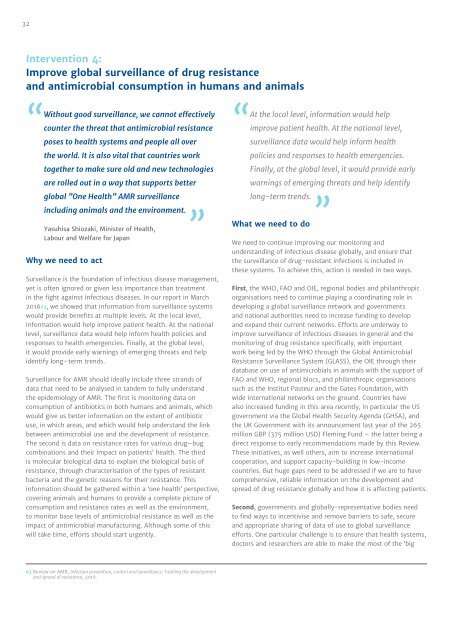TACKLING DRUG-RESISTANT INFECTIONS GLOBALLY FINAL REPORT AND RECOMMENDATIONS
qQvJ300ETXu
qQvJ300ETXu
You also want an ePaper? Increase the reach of your titles
YUMPU automatically turns print PDFs into web optimized ePapers that Google loves.
32<br />
Intervention 4:<br />
Improve global surveillance of drug resistance<br />
and antimicrobial consumption in humans and animals<br />
good surveillance, we cannot effectively<br />
“Without<br />
counter the threat that antimicrobial resistance<br />
poses to health systems and people all over<br />
the world. It is also vital that countries work<br />
together to make sure old and new technologies<br />
are rolled out in a way that supports better<br />
global ”One Health” AMR surveillance<br />
including animals and the environment.<br />
”<br />
Yasuhisa Shiozaki, Minister of Health,<br />
Labour and Welfare for Japan<br />
Why we need to act<br />
Surveillance is the foundation of infectious disease management,<br />
yet is often ignored or given less importance than treatment<br />
in the fight against infectious diseases. In our report in March<br />
201663, we showed that information from surveillance systems<br />
would provide benefits at multiple levels. At the local level,<br />
information would help improve patient health. At the national<br />
level, surveillance data would help inform health policies and<br />
responses to health emergencies. Finally, at the global level,<br />
it would provide early warnings of emerging threats and help<br />
identify long–term trends.<br />
Surveillance for AMR should ideally include three strands of<br />
data that need to be analysed in tandem to fully understand<br />
the epidemiology of AMR. The first is monitoring data on<br />
consumption of antibiotics in both humans and animals, which<br />
would give us better information on the extent of antibiotic<br />
use, in which areas, and which would help understand the link<br />
between antimicrobial use and the development of resistance.<br />
The second is data on resistance rates for various drug–bug<br />
combinations and their impact on patients’ health. The third<br />
is molecular biological data to explain the biological basis of<br />
resistance, through characterisation of the types of resistant<br />
bacteria and the genetic reasons for their resistance. This<br />
information should be gathered within a ‘one health’ perspective,<br />
covering animals and humans to provide a complete picture of<br />
consumption and resistance rates as well as the environment,<br />
to monitor base levels of antimicrobial resistance as well as the<br />
impact of antimicrobial manufacturing. Although some of this<br />
will take time, efforts should start urgently.<br />
“At the local level, information would help<br />
improve patient health. At the national level,<br />
surveillance data would help inform health<br />
policies and responses to health emergencies.<br />
Finally, at the global level, it would provide early<br />
warnings of emerging threats and help identify<br />
long‐term trends.<br />
”<br />
What we need to do<br />
We need to continue improving our monitoring and<br />
understanding of infectious disease globally, and ensure that<br />
the surveillance of drug-resistant infections is included in<br />
these systems. To achieve this, action is needed in two ways.<br />
First, the WHO, FAO and OIE, regional bodies and philanthropic<br />
organisations need to continue playing a coordinating role in<br />
developing a global surveillance network and governments<br />
and national authorities need to increase funding to develop<br />
and expand their current networks. Efforts are underway to<br />
improve surveillance of infectious diseases in general and the<br />
monitoring of drug resistance specifically, with important<br />
work being led by the WHO through the Global Antimicrobial<br />
Resistance Surveillance System (GLASS), the OIE through their<br />
database on use of antimicrobials in animals with the support of<br />
FAO and WHO, regional blocs, and philanthropic organisations<br />
such as the Institut Pasteur and the Gates Foundation, with<br />
wide international networks on the ground. Countries have<br />
also increased funding in this area recently, in particular the US<br />
government via the Global Health Security Agenda (GHSA), and<br />
the UK Government with its announcement last year of the 265<br />
million GBP (375 million USD) Fleming Fund – the latter being a<br />
direct response to early recommendations made by this Review.<br />
These initiatives, as well others, aim to increase international<br />
cooperation, and support capacity-building in low-income<br />
countries. But huge gaps need to be addressed if we are to have<br />
comprehensive, reliable information on the development and<br />
spread of drug resistance globally and how it is affecting patients.<br />
Second, governments and globally-representative bodies need<br />
to find ways to incentivise and remove barriers to safe, secure<br />
and appropriate sharing of data of use to global surveillance<br />
efforts. One particular challenge is to ensure that health systems,<br />
doctors and researchers are able to make the most of the ‘big<br />
63 Review on AMR, Infection prevention, control and surveillance: Tackling the development<br />
and spread of resistance, 2016.


